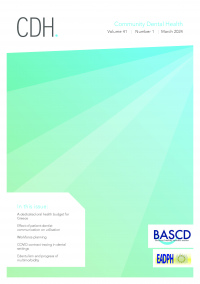March 2014
Editorial - Reviews of the literature: Expected standards
Abstract
As the scientific literature grows, reviews are increasingly useful ways of summarising vast bodies of evidence or indeed of highlighting evidence gaps that may initiate new research. Increased emphasis on evidence based medicine has fuelled the demand for high quality evidence syntheses. Reviews of the literature can help to keep busy clinicians up to date and to arm policy makers with necessary knowledge for important decisions around patient care. Due to the demand for reviews, a number of different types of literature review have emerged in recent years. A simple search of the dental literature in Web of Knowledge over the last year alone reveals a plethora of review types including systemic reviews, meta-analyses, critical reviews, narrative reviews, literature reviews, scoping reviews and qualitative systematic reviews. A number of examples from this range have been published in Community Dental Health in recent years including a systematic review of oral health related quality of life in cleft lip and/or palate patients (Antonarakis et al., 2013) and a literature review of methods for assessing caries in epidemiological surveys (Agbaje et al., 2012). In this edition alone, two reviews are featured, a narrative review of dentinal hypersensitivity (Cartwright, 2014) and a review of the literature on dietary advice provided by dental practitioners (Franki et al., 2013). The wide range of review types and ambiguity associated with some definitions may occasionally mean authors may risk mislabelling their review. Systematic reviews are perhaps the most clearly defined. The Cochrane Collaboration has named five key components of a systematic review: 1. clear set of objectives and eligibility criteria; 2. explicit and reproducible method; 3. a systematic search that could reasonably be assumed to identify all possible relevant records; 4. quality assessment of the included studies using an appropriate tool such as Risk of Bias and use of this assessment in interpretation of findings; 5. systematic presentation and synthesis of the characteristics and results of all included studies (Higgins and Green, 2011). A meta-analysis may be a feature of a systematic review but it is not a necessary component. A meta-analysis constitutes a statistical synthesis of outcome data of included studies. Due to their robust methods, meta-analyses and systematic reviews are considered to provide the highest level of evidence in determining the efficacy of an intervention (Evans, 2003) and may be especially useful to clinicians and policy makers.




